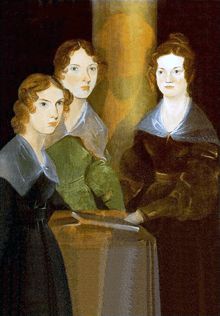Cowan Bridge School
Coordinates: 54°11′03″N 2°33′44″W / 54.1841°N 2.5621°W
.jpg)
Cowan Bridge School refers to the Clergy Daughters' School, a school mainly for the daughters of middle class clergy founded in the 1820s. It was first located in the village of Cowan Bridge in the English county of Lancashire, where it was attended by the Brontë sisters.[1] Two of the sisters, Maria and Elizabeth died from tuberculosis in the aftermath of a typhoid outbreak at the school. In the 1830s the school moved to Casterton, a few miles away, where it was amalgamated with another girls' school. The institution survived to the twenty-first century as Casterton School.
Conditions in the school
The Cowan Bridge school imposed a uniform on the children known as the Charity children, which humiliated the Brontës, who were among the youngest of the boarders. They suffered taunting from the older children, Charlotte especially, who owing to her short sightedness had to hold her nose to the paper to be able to read or write. They slept two in a bed with their heads propped up, rising before dawn, making their morning ablutions in a basin of cold water (shared with six other pupils) which had often frozen during the night for lack of any heating. They descended for an hour and a half of prayers before breakfasting on porridge, frequently burnt. [2] This is similar to Jane Eyre, where they get both burnt porridge and frozen water. They began their lessons at half past nine, ending at noon, followed by recreation in the garden until dinner, a meal taken very early. Lessons began again without pause until 5 p.m. When there was a short break for half a slice of bread and a small bowl of coffee and 30 minutes recreation, followed by another long period of study. The day ended with a glass of water, an oatcake, and evening prayers before bed. Punishments included privation of food and recreation, corporal punishment, and humiliations such as being made to sit on a stool for hours on end without moving, wearing a dunce's cap.[3]
The school described by Charlotte Brontë
.jpg)
This punishment is described by Charlotte in Jane Eyre and reports by Mrs Gaskell confirm this ill-treatment. Furthermore, when Mr Williams, reader at Smith, Elder & Co, congratulated her for the narrative vigour of her description, Charlotte, unusually vehemently, insisted that it was true, and that furthermore she had deliberately avoided telling everything so as not to be accused of exaggeration. Indeed, it is difficult to think that Charlotte, having persistently repeated for twenty years the stories about the bad treatment inflicted on her sisters, could have exaggerated or invented them. For example there is the description, given by an unidentified witness to Mrs Gaskell, of the little Maria who, very ill and having just received a suction cup placed on her right side by the doctor, rose suddenly on seeing Miss Andrews enter the room, and began to get dressed. Before she could slip into some clothing, however, the mistress pulled her violently into the centre of the room, scolding her for negligence and disorder, and punished her for being late, upon which Maria descended from the dormitory although she could hardly stand up. According to Mrs Gaskell, the witness spoke as if she saw it yet, and her whole face flashed out undying indignation.[4]
The hardest days were Sundays. In all weather, without adequate protective clothing, the pupils had to walk more than three miles (five km) over the fields to their pastor's church to attend the Sunday service. As the distance did not permit a return to the school, they were given a cold snack at the back of the church before evensong, then finally walked back to school. On arriving, cold and famished after the long walk, they were given a single slice of bread spread with rancid butter. Their Sunday devotions ended with long recitations from the catechism, learning long biblical texts by heart, and hearing a sermon of which the main theme was often eternal damnation. The Revd. Carus Wilson, unlike Patrick Brontë, was a Calvinist Evangelist who believed in predestination, and consequently in the damnation of the majority of souls. His preachings and writings, in the form of small manuals for the use of the pupils, were full of rhetorical force and other effects designed to make an impression on their young readers' minds.[5]
References
- ↑ Haworth Village Accessed 2014-06-03
- ↑ Karen Smith Kenyon: The Bronte Family: Passionate Literary Geniuses (2002), p. 23
- ↑ Juliet Barker: The Brontës (1995), pp. 120–123, 125–130, 134, 136–138, 140–141, 285
- ↑ Juliet Barker: The Brontës (1995), pp.134–135, 509–510
- ↑ Juliet Barker: The Brontës (1995), pp. 136–137
External links
- Photos of the original Clergy Daughters' School building taken May 3, 1985.
